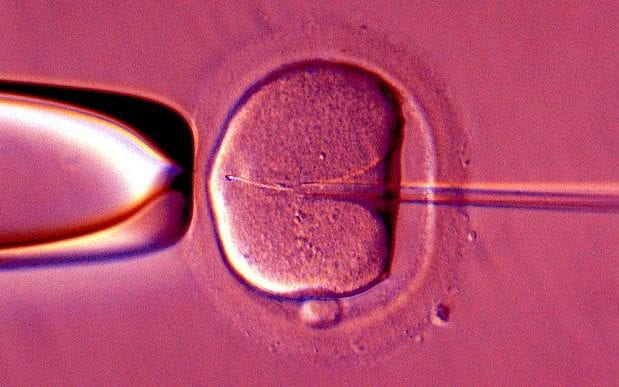Page 9322
Apr 1, 2019
Jellyfish-inspired electronic skin can heal itself while wet
Posted by Genevieve Klien in category: robotics/AI

A new self-healing electronic skin could improve water-resistant touchscreens and soft robots. And reduce waste, too.
Apr 1, 2019
Children born through IVF have a greater risk of developing childhood cancer, study suggests
Posted by Genevieve Klien in category: biotech/medical
Children born through IVF have a greater risk of developing childhood cancer, the largest study of its kind has found.
Researchers in the US found that the risk of childhood cancer increases from 1.9 cases in 10,000 youngsters to 2.5 in those born through fertility treatment, an increase of around 31 per cent.
Although the study is only observational, previous research has suggested that drugs used to stimulate the ovaries to produce eggs during fertility treatment, or the nutritious chemical soup in which embryos are grown may cause disease.
Apr 1, 2019
EHF Fellow: Nathan Doctor
Posted by Alan R. Light in categories: biotech/medical, business, computing, education
Outcome-based education. This is about a man who is involved in a system designed to train and assess the skills of computer programmers, but I wonder if the ideas could be applied to other types of learning.
For that matter, it strikes me that merit badges in the Boy Scouts may work along similar lines.
Nathan chose all-in, investing his entire life savings in a single stock-market exchange, and made enough money to keep the business alive. The past several years have been full of similar tests of commitment but Nathan and his business partner have weathered them all, building a groundbreaking company called Qualified.
Apr 1, 2019
My Experiences At Undoing Aging 2019
Posted by Steve Hill in categories: biotech/medical, internet, life extension

https://youtube.com/watch?v=jrFU5wyd_C0
A personal report from the recent Undoing Aging conference in Berlin by Nicola Bagalà. The event saw many of the leading figures in aging research and rejuvenation biotechnology attend a packed conference which celebrates its second successful year.
Last Wednesday, I landed in Berlin, Germany at around 12:30. About an hour later, I was briefly in Cafè Alex, right next to the tapering TV Tower, where I met some of my colleagues from LEAF—some of whom I had never seen in person before—as well as other volunteers and members of HEALES, our friend organization. We were all there to attend the Undoing Aging 2019 conference, which would take place over the course of the next three days, bringing together experts and researchers from all over the world to discuss the latest advances, network, and share views on the biology of aging.
Apr 1, 2019
Julie Hill to Ground Control: An OC icon will be one of the first astrotourists
Posted by Klaus Baldauf in category: futurism
Entrepreneur Julie Hill broke through the glass ceiling. Now she wants to break through the stratosphere.
Apr 1, 2019
Mysterious 4,000-year-old lost city discovered
Posted by Genevieve Klien in category: futurism
A team of French archaeologists has located the remains of a lost ancient city in Iraqi Kurdistan.
Over the course of six excavations between 2012 and 2018, researchers uncovered the ancient city at Kunara, near the Zagros mountains. Previously, experts had been prevented from exploring the site, near the modern city of Sulaymaniyah, by Saddam Hussein’s regime and conflicts in the region.
The discovery is described in the French National Center for Scientific Research (CNRS) journal.
Continue reading “Mysterious 4,000-year-old lost city discovered” »
Apr 1, 2019
French govt outlines measures to improve autism care
Posted by Genevieve Klien in categories: biotech/medical, education, government, neuroscience
PARIS (AP) — The French government has outlined measures to ensure early diagnostic testing for young children with autism and help for them going to school.
In a statement following a Cabinet meeting Monday, the government promised that expenses linked to diagnostic testing will be fully reimbursed.
Measures include opening specific classes at preschools and elementary schools, and putting in place teacher and medical staff training and research to better understand autism, a neurodevelopmental disorder.
Apr 1, 2019
Europe Stores Electricity in Gas Pipes
Posted by Genevieve Klien in categories: solar power, sustainability
Converting excess wind and solar power into hydrogen can extend renewable energy’s reach.
- By Peter Fairley on April 1, 2019
Apr 1, 2019
Depression, obesity, chronic pain could be treated by targeting the same key protein
Posted by Genevieve Klien in categories: biotech/medical, neuroscience
Major depression, obesity and chronic pain are all linked to the effects of one protein, called “FK506-binding protein 51,” or FKBP51. Until now, efforts to inhibit this target have been hampered by the difficulty of finding something specific enough to do the job and not affect similar proteins. Now a research group has developed a highly selective compound that can effectively block FKBP51 in mice, relieving chronic pain and having positive effects on diet-induced obesity and mood. The new compound also could have applications in alcoholism and brain cancer.














